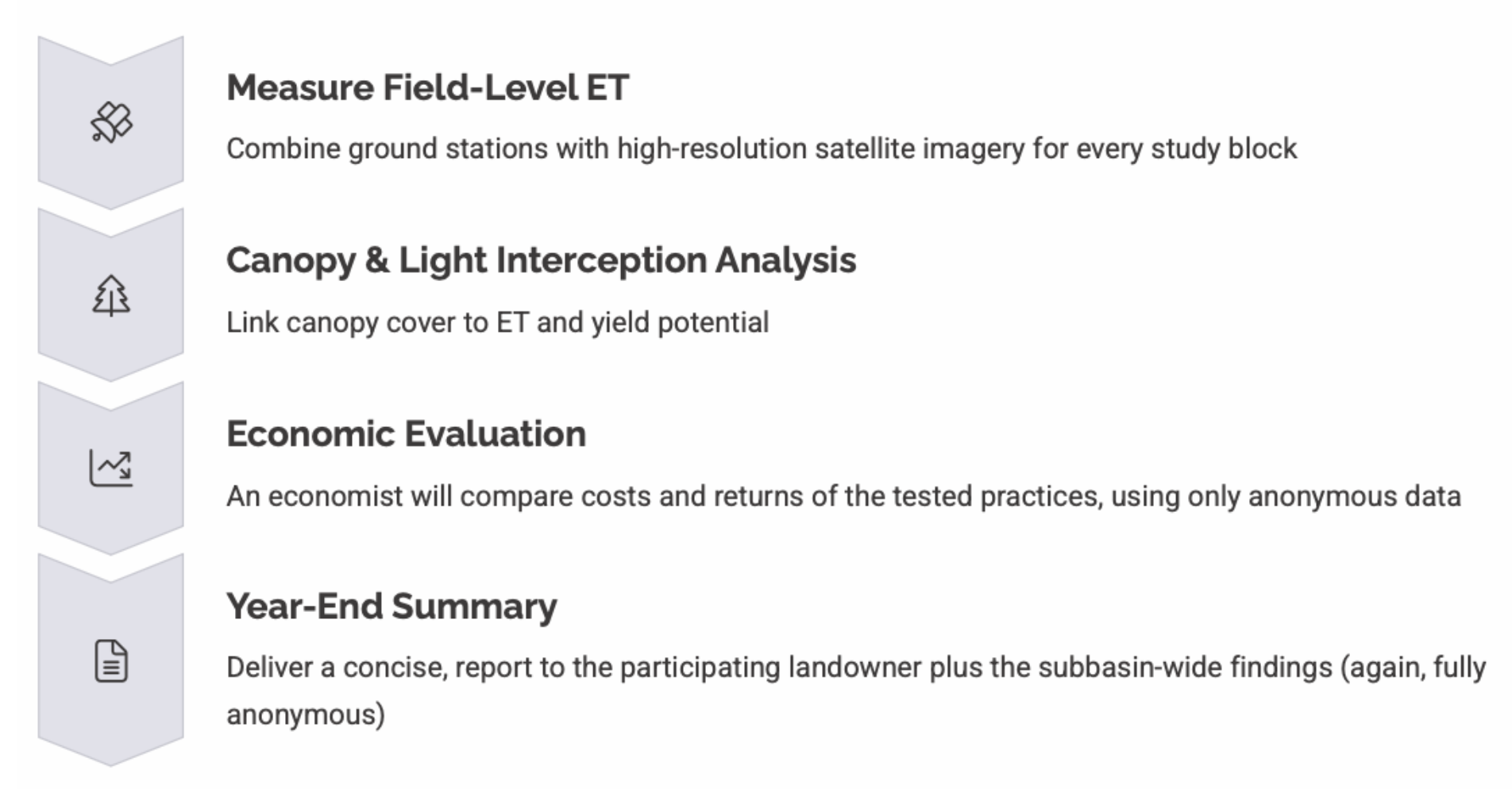Demand Reduction Strategies Project
The Vina Subbasin’s Demand Reduction Strategies Project aims to reduce groundwater use with affecting yields.

This project includes two pilot projects. One focuses on extending the fallow period for 1-2 years between orchard removal and replanting; the other explores precision irrigation. Representative orchards in the Subbasin that fit the Eligibility Criteria were selected for one or both pilots. We’re aiming to develop about 10 case studies per pilot using information shared by participating landowners. The insights gained will help shape a long-term groundwater management strategy for the Vina Subbasin that is expected to reduce groundwater use by a minimum of 4,000 to 8,000 acre-feet per year.
This pilot program is supported by a trusted team of experts, including Tom Devol, a leader in sensor-based irrigation technologies; Allan Fulton, a veteran UC advisor with decades of experience in efficient orchard irrigation management; Joel Kimmelshue, a Butte County-area native and soil scientist specializing in agricultural water systems; and Joe Connell, a former UC Cooperative Extension advisor known for his long-standing service to North State growers.

Consultant: Geosyntec/LandIQ
Project Partner: Agricultural Groundwater Users of Butte County
Total Project Budget: $1,600,000
PROJECT CONTRACTS:
VX0003_Geosyntec (Demand Reduct & Lindo Channel).pdfVX0001_AGUBC (Demand Reduct & Surface Water Supply).pdfProject Status and Expected Outcomes

Project Progress
-
Public Review of EOR Guidelines
- Draft Extend Orchard Replacement (EOR) Guidelines were developed and released for public review and comment on October 24, 2024, with the comment period closing on November 25, 2024.
- Based on feedback from DWR and local stakeholders, including a Local Expert Group (LEG) convened in late January, the Vina GSA and project team revised the DRS pilot programs and re-allocated a significant portion of the DRS implementation funds to other components (i.e., to the Data Gap Identification and Data Improvement & Water Supply and Recharge components)
-
Revised Pilot Program Development
- Instead of providing grant funded incentives to growers to implement the pilot programs, the project team has hired project-based Subject Matter Experts to work with Land IQ’s team of researchers to do the following:
- Gather spatial data and develop necessary tools
- Conduct outreach to growers to select suitable almond and walnut orchards for the EOR and Precision Irrigation pilots
- Collect history from landowners on yield, and management and cultural practices, to diagnose non-beneficial ET sources
- Formulate pilot orchard plans with targeted management changes, i.e., improved irrigation scheduling, advanced irrigation and sensor technologies, fertilizer management, orchard floor practices, etc.
- Work with farmers to apply and document new practices during the 2025 growing season.
- Monitor ET changes, quantify water savings, and develop final recommendations for the entire subbasin.
- Instead of providing grant funded incentives to growers to implement the pilot programs, the project team has hired project-based Subject Matter Experts to work with Land IQ’s team of researchers to do the following:
-
Implementation & Current Status
- The Subject Matter Expert (SME) Team is working with landowners that represent more than 30,000 acres in the Vina Subbasin.
- An economic evaluation comparing costs and returns of the tested practices is being performed.
- Monthly ET information is being provided to the Vina GSA.
- Ground-based sensor technology stations have been installed throughout the Vina Subbasin. These stations will validate and add greater certainty to the satellite generate ET and canopy data.
- A survey is being developed for distribution to farmers throughout the Vina Subbasin that will gauge farmer’s.
Webinar Recording and PowerPoints
Demand Reduction Strategies Webinar Video.mp4Demand Reduction Strategies Webinar Audio.m4aLand IQ_Demand Reduction Strategies - PPT.pdfAGUBC_Demand Reduction Strategies - PPT.pdfDemand Reduction Strategies Informational Flyer.pdfDRS Presentation_01-15-25.pdfDRS Presentation_02-26-25.pdf04-09-25 VGSA Board Reallocation Presentation.pdf
